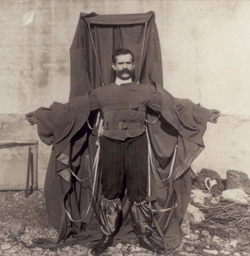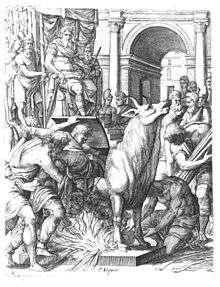List of inventors killed by their own inventions

Franz Reichelt (d. 1912) attempted to use this contraption as a parachute. Reichelt died after he jumped off the Eiffel Tower wearing his invention, which failed to operate as expected.
This is a list of inventors whose deaths were in some manner caused by or related to a product, process, procedure, or other innovation that they invented or designed.
Direct casualties
Automotive
- Fred Duesenberg (1876–1932), killed in high speed road accident in a Duesenberg automobile.[1]
- William Nelson (c. 1879−1903), a General Electric employee, invented a new way to motorize bicycles. He then fell off his prototype bike during a test run.[2]
- Sylvester H. Roper, inventor of the eponymous steam-powered bicycle, died of a heart attack or subsequent crash during a public speed trial in 1896. It is unknown whether the crash caused the heart attack or vice versa.[3]
- Francis Edgar Stanley (1849–1918), killed while driving a Stanley Steamer automobile. He drove his car into a woodpile while attempting to avoid farm wagons travelling side by side on the road.[4]
Aviation
- Ismail ibn Hammad al-Jawhari (died c. 1003–1010), a Muslim Kazakh Turkic scholar from Farab, attempted to fly using two wooden wings and a rope. He leapt from the roof of a mosque in Nishapur and fell to his death.[5]
- Jean-François Pilâtre de Rozier was the first known fatality in an air crash when his Rozière balloon crashed on 15 June 1785 while he and Pierre Romain attempted to cross the English Channel.
- Otto Lilienthal (1848–1896) died the day after crashing one of his hang gliders.[6]
- Franz Reichelt (1879–1912), a tailor, fell to his death off the first deck of the Eiffel Tower while testing his invention, the coat parachute. It was his first attempt with the parachute, and he had told the authorities he would first test it with a dummy.[7]
- Aurel Vlaicu (1882–1913) died when his self-constructed airplane,[8] Vlaicu II, failed during an attempt to cross the Carpathian Mountains by air.[9]
- Henry Smolinski (died 1973) was killed during a test flight of the AVE Mizar, a flying car based on the Ford Pinto and the sole product of the company he founded.[10]
- Michael Dacre (died 2009, age 53) died after testing his flying taxi device designed to permit fast, affordable travel between regional cities.[11]
Industrial
- William Bullock (1813–1867) invented the web rotary printing press.[12][13] Several years after its invention, his foot was crushed during the installation of a new machine in Philadelphia. The crushed foot developed gangrene and Bullock died during the amputation.[14]
Maritime

Hunley Submarine
- Horace Lawson Hunley (died 1863, age 40), Confederate marine engineer and inventor of the first combat submarine, Hunley, died during a trial of his vessel. During a routine test of the submarine, which had already suffered one accident, Hunley took command. After failing to resurface, Hunley and the seven other crew members drowned.[14] The navy salvaged the submarine and put it back into use.
Medical
- Thomas Midgley, Jr. (1889–1944) was an American engineer and chemist who contracted polio at age 51, leaving him severely disabled. He devised an elaborate system of ropes and pulleys to help others lift him from bed. He was accidentally entangled in the ropes of the device and died of strangulation at the age of 55. However, he is more famous—and infamous—for two of his other inventions: the tetraethyl lead (TEL) additive to gasoline, and chlorofluorocarbons (CFCs).[15][16][17]
- Alexander Bogdanov (22 August 1873 – 7 April 1928) was a Russian physician, philosopher, science fiction writer and revolutionary of Belarusian ethnicity who experimented with blood transfusion, attempting to achieve eternal youth or at least partial rejuvenation. He died after he took the blood of a student suffering from malaria and tuberculosis, who may have also been the wrong blood type.[18][19]
Physics
- Marie Curie (1867–1934) invented the process to isolate radium after co-discovering the radioactive elements radium and polonium.[20] She died of aplastic anemia as a result of prolonged exposure to ionizing radiation emanating from her research materials. The dangers of radiation were not well understood at the time.[14][21]
- Some physicists who worked on the invention of the atom bomb at Los Alamos died from radiation exposure, including Harry Daghlian (1921–1945) and Louis Slotin (1910–1946), who both were exposed to lethal doses of radiation in separate criticality accidents involving the same sphere of plutonium.[22]
- Sabin Arnold von Sochocky invented the first radium-based luminescent paint, but eventually died of aplastic anemia resulting from his exposure to the radioactive material.[23]
Publicity and entertainment
- Karel Soucek (19 April 1947 – 20 January 1985) was a Canadian professional stuntman who developed a shock-absorbent barrel. He died following a demonstration involving the barrel being dropped from the roof of the Houston Astrodome. He was fatally wounded when his barrel hit the rim of the water tank meant to cushion his fall.[24]
Railways
- Valerian Abakovsky (1895–1921) constructed the Aerowagon, an experimental high-speed railcar fitted with an aircraft engine and propeller traction; it was intended to carry Soviet officials. On 24 July 1921, a group led by Fyodor Sergeyev took the Aerowagon from Moscow to the Tula collieries to test it, with Abakovsky also on board. They successfully arrived in Tula, but on the return route to Moscow the Aerowagon derailed at high speed, killing everyone on board, including Abakovsky (at the age of 25).[25]
- George Jackson Churchward CBE (1857–1933), former Chief Mechanical Engineer of the Great Western Railway (GWR), was struck and killed by a Paddington to Fishguard express, pulled by No. 4085 'Berkeley Castle'. The locomotive was of the GWR Castle class, a successful design by Charles Collett and greatly influenced by Churchward.
Rocketry
- Max Valier (1895–1930) invented liquid-fuelled rocket engines as a member of the 1920s German rocketeering society Verein für Raumschiffahrt. On 17 May 1930, an alcohol-fuelled engine exploded on his test bench in Berlin, killing him instantly.[26]
Popular myths and related stories

Perillos being pushed into his brazen bull
- James Douglas, 4th Earl of Morton (1581) was executed in Edinburgh on the Scottish Maiden which he had introduced to Scotland as Regent,[27] albeit he was not the inventor of the device.
- Jim Fixx (1932–1984) authored the best-selling book, The Complete Book of Running (1977), and is credited with helping start America's fitness revolution, popularizing the sport of running and demonstrating the health benefits of regular jogging. On 20 July 1984, Fixx died at the age of 52 of a fulminant heart attack, after his daily run, on Vermont Route 15 in Hardwick, Vermont.[28][29]
- Joseph-Ignace Guillotin (1738–1814) While he did not invent the guillotine, his name became an eponym for it.[30] Rumors circulated that he died by the machine, but historical references show that he died of natural causes.[31]
- James "Jimi" Heselden (1948–2010), having recently purchased the Segway production company, died in a single-vehicle Segway accident. (Dean Kamen invented the Segway.)[32]
- Li Si (208 BCE), Prime Minister during the Qin dynasty, was executed by the Five Pains method which some sources claim he had devised.[33][34][35] However the history of the Five Pains is traced further back in time than Li Si.
- Perillos of Athens (circa 550 BCE), according to legend, was the first to be roasted in the brazen bull he made for Phalaris of Sicily for executing criminals.[36][37]
- Wan Hu, a 16th-century Chinese official, is said to have attempted to launch himself into outer space in a chair to which 47 rockets were attached. The rockets exploded, and it is said that neither he nor the chair were ever seen again.
See also
- Darwin Awards
- List of entertainers who died during a performance
- List of unusual deaths
- Petard (as in "hoisted by one's own petard")
References
- ↑ "F. S. Duesenberg Dies of Auto Injury". New York Times. 27 July 1932. p. 17.
- ↑ "KILLED BY OWN INVENTION; While Trying Motor Bicycle He Had Made, Schenectady Man Meets Death — Article Preview". New York Times. 4 October 1903. Retrieved 22 November 2014.
- ↑ "Died in the Saddle", Boston Daily Globe, p. 1, 2 June 1896
- ↑ Doris A. Isaacson, ed. (1970). Maine: A Guide "Down East" (second ed.). Rockland, Maine: Courier-Gazette, Inc. Maine League of Historical Societies and Museums. p. 386. (First edition).
- ↑ google.com Piero Boitani, Winged words: flight in poetry and history. University of Chicago Press, 2007. p. 38. Retrieved 22 November 2014.
- ↑ Biography of Otto Lilienthal Lilienthal Museum
- ↑ 2003 Personal Accounts Darwin Awards
- ↑ Great Britain Patent GB191026658
- ↑ Ralph S. Cooper, D.V.M. "Aurel Vlaicu at www.earlyaviators.com". Retrieved 22 November 2014.
- ↑ Morris, Neil (2010). From Fail to Win, Learning from Bad Ideas: Transportation. ISBN 1-4109-3911-1.
- ↑ "British inventor dies in crash on test flight of his flying taxi". The Evening Standard. Retrieved 22 November 2014.
- ↑ "United States Patent 61996". Retrieved 22 November 2014.
- ↑ "United States Patent 100,367". Retrieved 22 November 2014.
- 1 2 3 "Inventors killed by their own inventions". Discovery News. Retrieved 2010-10-30.
- ↑ Bryson, Bill. A Short History of Nearly Everything. (2003) Broadway Books, USA. ISBN 0-385-66004-9
- ↑ Alan Bellows (2007-12-08). "The Ethyl-Poisoned Earth". Damn Interesting.
- ↑ "Milestones, Nov. 13, 1944" Time, November 13, 1944
- ↑ "Transfusion Medical Reviews". 2007: 337–340.
- ↑ "Alexander Bogdanov: the forgotten pioneer of blood transfusion.". US National Library of Medicine National Institutes of Health (PubMed.gov). Retrieved 2012-11-19.
- ↑ "American Institute of Physics Biography of Marie Curie". Retrieved 22 November 2014.
- ↑ American Institute of Physics Biography of Marie Curie
- ↑ "Criticality accidents". Retrieved 22 November 2014.
- ↑ "RADIUM PAINT TAKES ITS INVENTOR'S LIFE; Dr. Sabin A. von Sochocky Ill a Long Time, Poisoned by Watch Dial Luminant. 13 BLOOD TRANSFUSIONS Death Due to Aplastic Anemia-- Women Workers Who Were Stricken Sued Company.", The New York Times, November 15, 1928.
- ↑ Associated Press (21 January 1985). "35,000 Watch as Barrel Misses Water Tank : 180-Ft. Drop Ends in Stunt Man's Death". Los Angeles Times. Retrieved 18 August 2012.
- ↑ Alexey Abramov / Алексей Абрамов By the Kremlin Wall / У кремлёвской стены Moscow / М., Politizdat / Политиздат 1978 pp./стр. 399 (Russian)
- ↑ "American Institute of Aeronautics and Astronautics". Retrieved 22 November 2014.
- ↑ "The Maiden". National Museums Scotland. Retrieved 6 August 2010.
- ↑ "Why sports people get heart attack". Bystander.homesteader.com.
- ↑ McDougall, Christopher (20 July 2009). "To live is to jog". BBC News Magazine. BBC. Retrieved 20 August 2011.
- ↑ Chambers, William; Chambers, Robert (January–June 1844). "Dr Guillotin". Chambers's Edinburgh Journal. I: 218–221. Retrieved 2009-12-30.
- ↑ "Joseph Ignace Guillotin". Who Named It?.
- ↑ "Segway company owner dies in apparent Segway accident". CNN. 27 September 2010. Retrieved 27 September 2010.
- ↑ Guisso, R. W. L., The first emperor of China, New York : Birch Lane Press, 1989. ISBN 1-55972-016-6. Cf. p.37
- ↑ Fu, Zhengyuan, Autocratic tradition and Chinese politics, Cambridge University Press, 1993. Cf. p.126
- ↑ "The Civilization of China, Chapter II: Law and Government". Retrieved 11 August 2011.
- ↑ "Perillos of the Brazen Bull". Retrieved 25 July 2010.
- ↑ "The Brazen Bull". Retrieved 1 October 2011.
Further reading
- E. Cobham Brewer (1898). "Inventors Punished by their own inventions". Dictionary of Phrase and Fable. Bartleby. pp. 657–658.
External links
This article is issued from Wikipedia - version of the 11/8/2016. The text is available under the Creative Commons Attribution/Share Alike but additional terms may apply for the media files.